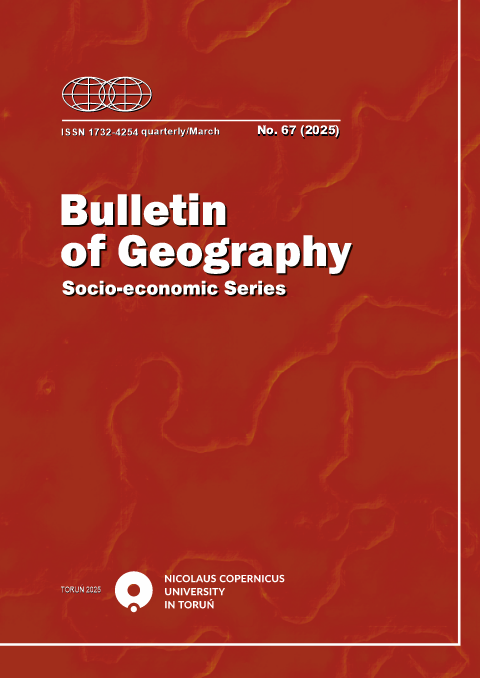The Rest of the World sector’s role in the intersectoral flow of funds systems of the Visegrad Group countries
DOI:
https://doi.org/10.12775/bgss-2025-0012Keywords
Visegrad Group, geography, planning & development, input-output analysis, national accountsAbstract
The study aims to assess the involvement of the Rest of the World (RoW) sector in the economies of Poland, the Czech Republic, Slovakia, and Hungary (the Visegrad Group, V4) as manifested by its short-term impact on disposable income (and other macro categories) through exports, investment grants, and the acquisition of financial assets. We propose a method that provides unambiguous and replicable results based on a standardised accounting system that is congruent across all European countries. The starting point is the sequence of records in the System of National Accounts (SNA). Then we construct an Input–Output Table for Institutional Sectors. Finally, we build a simple input–output model and conduct a deterministic simulation that is equivalent to the hypothetical extraction method. The main conclusion is that exports are the most important channel of foreign influence on the economy.
References
Almon, C. (2011). The Craft of Economic Modeling, Part III Multisectoral Models. University of Maryland.
Board of Governors of the Federal Reserve System (1955). Flow of Funds in the United States 1939–1953, Available at: https://fraser.stlouisfed.org/files/docs/releases/z1/z1_flowoffunds1939-1953.pdf.
Burkowski, E. & Kim, J. (2018). Flow-of-funds analysis in the Brazilian economy (2004 2014), 696. Institute of Developing Economies, Japan External Trade Organization (JETRO). DOI: https://doi.org/10.20561/00050220.
Burkowski, E. & Kim, J. (2019). Did the recent Brazilian economic defaults originate from real economic or financial issues? (No. 751). Institute of Developing Economies, Japan External Trade Organization (JETRO). DOI: https://doi.org/10.20561/00050810.
Copeland, M.A. (1949). Social accounting for moneyflows. The Accounting Review, 24(3): 254–264. Available at: http://www.jstor.org/stable/240684.
Dawson, J.C. (2004). The Asian crisis and flow-of-funds analysis. Review of Income and Wealth, 50(2): 243–260. Available at: http://www.roiw.org/2004/243.pdf.
Dietzenbacher, E., van Burken, B. & Kondo, Y. (2019). Hypothetical extractions from a global perspective. Economic Systems Research, 31(4): 505–519. DOI: https://doi.org/10.1080/09535314.2018.1564135.
Eurostat database. (2024). Available at: Database - Eurostat (europa.eu).
Federal Reserve Statistical Release (2021). Financial Accounts of the United States. Available at: https://www.federalreserve.gov/releases/z1/release-dates.htm.
Hagino, S. & Kim, J. (2021). Compilation and analysis of international from-whom-to-whom financial stock table for Japan, Korea, the United States, and China. Economic Structures, 10: 23, DOI: https://doi.org/10.1186/s40008-021-00254-4.
Kim, J. (2017). Corporate financial structure of South Korea after Asian financial crisis: the chaebol experience. Journal of Economic Structures, 6(1): 1–14. DOI: https://doi.org/10.1186/s40008-017-0085-8.
Klein, L.R. (2003). Some Potential Linkages for Input-Output Analysis with Flow-of-Funds. Economic Systems Research, 15(3): 269–277. DOI: https://doi.org/10.1080/0953531032000111772.
Kuznets, S.S. (1937). National income and capital formation. 1919–1935: A Preliminary Report. New York. National Bureau of Economic Research. DOI: https://doi.org/10.2307/2225444.
Lach, Ł. (2020). Tracing key sectors and important input-output coefficients: Methods and applications. C.H. Beck, Warsaw.
Leontief, W.W. (1936). Quantitative input and output relations in the economic systems of the United States. Review of Economics and Statistics, 18: 105–125. DOI: https://doi.org/10.2307/1927837.
Miller, R.E. & Blair, P.D. (2009). Input–output analysis: foundations and extensions. Cambridge University Press.
Nishiyama, S. (2008). A financial macroeconometric model of the United States. Journal of Applied Input-Output Analysis, 13–14: 1-31. Available at: http://www.gakkai.ne.jp/papaios/en/img/jaia2008_13-1.pdf.
Okuma, R. (2012). Sectoral interlinkages in balance sheet approach. IFC Bulletin, 36: 387–404. Available at: http://www.bis.org/ifc/publ/ifcb36z.pdf.
Palumbo, M. & Parker, J. (2009). The integrated financial and real system of national accounts for the US: Does it presage the financial crises? National Bureau of Economic Research, w14663. Available at: https://www.jstor.org/stable/25592379.
Pedauga, L., Velázquez, A. & Bueno, M. (2018). Property income from-whom-to-whom matrices: A dataset based on financial assets–liabilities stocks of financial instrument for Spain. Data in brief, 19: 449–455. DOI: https://doi.org/10.1016/j.dib.2018.05.018.
Przybyliński, M. & Trębska, J. (2023). Intersectoral flows in the economies of the Visegrad Group Countries. Comparative Economic Research. Central and Eastern Europe, 26(3): 31-52. DOI: https://doi.org/10.18778/1508-2008.26.20.
Shrestha, M., Mink, R. & Fassler, S. (2012). An integrated framework for financial positions and flows on a from-whom-to-whom basis: concepts, status, and prospects. International Monetary Fund. Available at: An Integrated Framework for Financial Positions and Flowson a From-Whom-To-Whom Basis: Concepts, Status, and Prospects (imf.org).
Financial Stability Board and International Monetary Fund (2009). The Financial Crisis and Information Gaps—Report to the G-20 Finance Ministers and Central Bank Governors, Washington, D.C.
Trębska, J. (2018). Polish households’ savings in the financial intersectoral linkages, Equilibrium. Quarterly Journal of Economics and Economic Policy, 13(2): 307–329. DOI: https://doi.org/10.24136/eq.2018.016.
Tsujimura, K. & Mizoshita, M. (2003). Asset-liability-matrix analysis derived from the flow-of-funds accounts: the bank of Japan’s quantitative monetary policy examined. Economic Systems Research, 15(1): 51–67. DOI: https://doi.org/10.1080/0953531032000056936.
Tsujimura, M. & Tsujimura, K. (2011). Balance sheet economics of the subprime mortgage crisis. Economic Systems Research, 23(1): 1–25. DOI: https://doi.org/10.1080/09535314.2010.523414.
Tsujimura, K. & Tsujimura, M. (2018). A flow of funds analysis of the US quantitative easing. Economic Systems Research, 30(2): 137–177. DOI: https://doi.org/10.1080/09535314.2018.1443908.
Tsujimura, M. & Tsujimura, K. (2021). Flow-of-funds structure of the US economy 2001–2018. Economic Systems Research, 33(3): 385–416. DOI: https://doi.org/10.1080/09535314.2020.1795629.
Yoshino, N. & Mizoguchi, T. (2013). Change in the Flow of Funds and the Fiscal Rules Needed for Fiscal Stabilization. Public Policy Review, Policy Research Institute, Ministry of Finance Japan, 9(1): 51–70. Available at: https://ideas.repec.org/a/mof/journl/ppr020c.html.
Zhang, N. & Zhao, X. (2019). Measuring global flow of funds: focus on China, Japan, and the United States. Economic Systems Research, 31(4): 520–550. DOI: https://doi.org/10.1080/09535314.2019.1574719.
Zhang, N. & Zhu, L. (2021). Global Flow of Funds as a Network: The Case Study of the G20. Japanese Journal of Monetary and Financial Economics, 9: 21–56. DOI: https://doi.org/10.32184/jjmfe.9.0_21.
Published
How to Cite
Issue
Section
License
Copyright (c) 2025 Michał Przybyliński, Joanna Trębska

This work is licensed under a Creative Commons Attribution-NonCommercial 4.0 International License.
Title, logo and layout of journal Bulletin of Geography. Socio-economic Series are reserved trademarks of Bulletin of Geography. Socio-economic Series.Stats
Number of views and downloads: 331
Number of citations: 0



